In the horse-and-buggy days of home heating and cooling, adjusting your thermostat was a manual affair that could hardly be called efficient. Today, integrating a smart thermostat into your smart home system isn't just about keeping up with the Joneses; it's about enhancing your home's energy efficiency and comfort.
With a few taps on your smartphone or simple voice commands, you can control your home's climate from anywhere. But the true magic lies in how these devices learn from your habits to optimize heating and cooling without your constant input.
While the perks are clear, there's a lot to consider before making your home smarter. How do you choose the right system, and what should you know about installation and compatibility? Let's explore the essentials to make your smart home integration as seamless as your morning routine.
Key Takeaways
- Smart thermostats act as the central hub for intelligent HVAC integration, enhancing home comfort and efficiency.
- Integration with platforms like Google Home, Amazon Alexa, and Apple HomeKit allows for voice-controlled temperature adjustments.
- Zoned heating and cooling setups, enabled by smart thermostats, provide personalized comfort and energy savings.
- AI and sensor technology in smart thermostats adapt to user habits and occupancy, optimizing climate control automatically.
Understanding Smart Home Technology
Smart home technology often streamlines and automates your household functions, making daily life both more convenient and efficient. By integrating smart home devices, such as thermostats, sensors, and smart vents, you gain precise control over your home's temperature and energy use.
These devices work together seamlessly, allowing for smarter heating and cooling strategies that adapt to your lifestyle. With smart integration, you can easily manage these devices through a central platform or even voice commands, thanks to compatibility with systems like Google Home and Amazon Alexa.
This not only simplifies how you interact with your home's climate but also enhances your comfort and slashes your energy bills. Embracing smart technology means stepping into a world where your home intelligently responds to your needs.
The Core of Smart HVAC Integration: Smart Thermostats
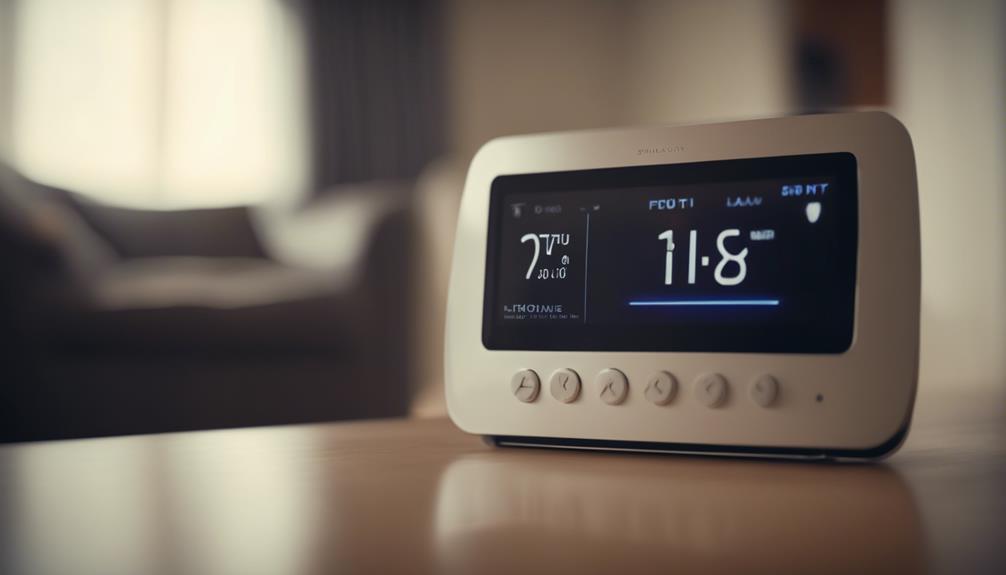
Building on the foundation of smart home technology, let's focus on smart thermostats, the heart of intelligent HVAC integration. These devices are more than just temperature regulators; they're the core of a smarter, more comfortable home environment. Here's why:
- Remote Control: Operate your thermostat anywhere using smartphone apps or voice assistants.
- Learning Ability: Smart thermostats adjust to your habits for best comfort and energy efficiency.
- Zoned Heating and Cooling: Customize climate settings in different areas for enhanced comfort.
- Integration with Smart Devices: Seamlessly connect with other smart home technology for a unified system.
Connecting With Home Automation Platforms
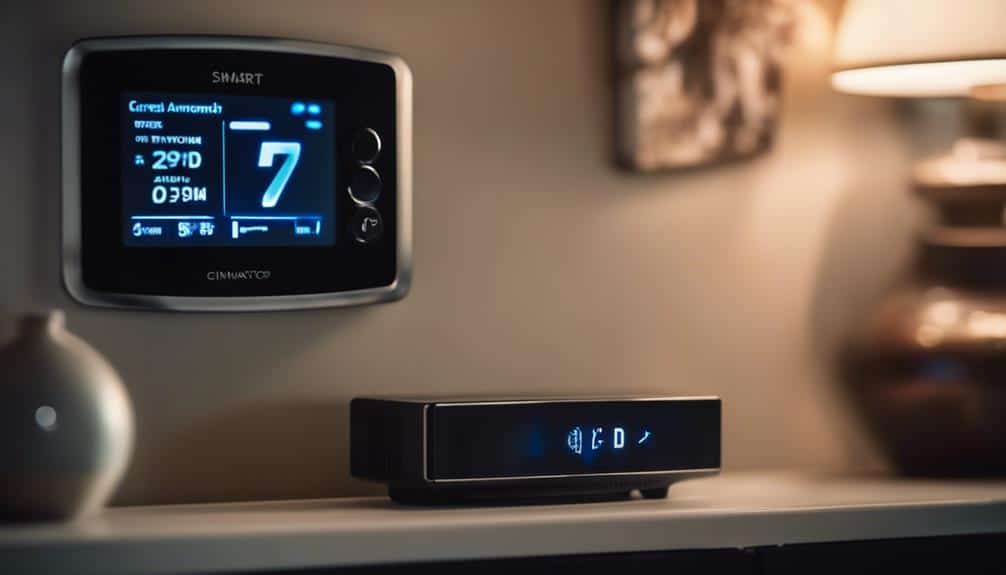
By integrating with leading home automation platforms like Google Home, Amazon Alexa, and Apple HomeKit, your smart thermostat becomes a pivotal control point in your smart home ecosystem. This seamless connection allows you to manage your home's climate with simple voice commands or through the convenience of platform apps, transforming your smart thermostat into a unified control hub for a multitude of devices.
Such integration not only enhances the user experience by offering a streamlined approach to home climate control but also promotes increased comfort and energy efficiency. You'll find managing your smart home's environment becomes effortlessly convenient, thanks to the smart home platforms' support.
This synergy between your smart thermostat and popular home automation systems ensures a cohesive and efficient smart home setup, maximizing both comfort and energy savings.
Enhancing Comfort With Zoned Heating and Cooling
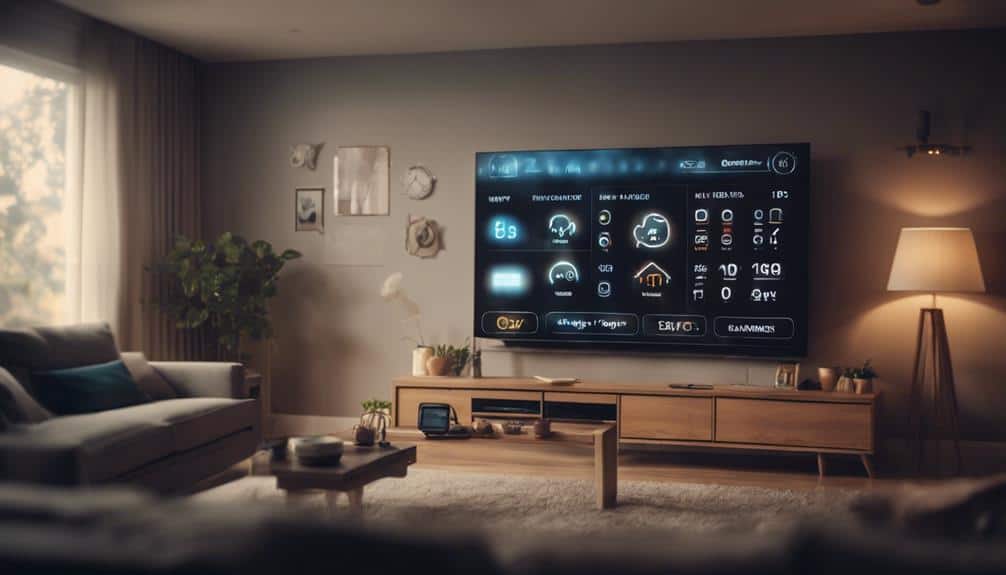
After integrating your smart thermostat with home automation systems, you can now explore zoned heating and cooling options to enhance your comfort. This approach allows you to customize the climate across different areas of your home, ensuring each space is exactly as warm or cool as you like it.
Here's why you should consider it:
- Energy Efficiency: Zoned systems use less energy by heating or cooling only occupied areas.
- Enhanced Comfort: Independent temperature adjustment in each zone means personalized comfort.
- Smart Vents and Sensors: These work together for precise climate control.
- Optimized Use: Your system adjusts automatically, ensuring the most efficient comfort without manual intervention.
Immerse yourself in zoned heating and cooling to create the perfect environment in every room.
The Role of Sensors and AI

You'll find that sensors and AI are the backbone of smart thermostats, making your home more comfortable and energy-efficient.
They detect changes and adjust your home's climate automatically, tailoring the environment to your preferences.
Let's explore how sensor technology and AI integration methods enhance your living space.
Sensor Technology Overview
Smart thermostats, leveraging sensor technology and AI, are revolutionizing how we optimize home climate for both efficiency and comfort. Sensors in smart HVAC systems use AI algorithms to adapt swiftly to environmental changes and occupancy patterns, ensuring your home is always at the perfect temperature.
- Motion sensors detect activity, adjusting temperatures in occupied rooms.
- Humidity sensors maintain comfort levels, balancing the air moisture.
Improving energy efficiency is greatly enhanced, reducing utility bills.
User comfort is enhanced, creating a tailored climate experience in smart homes.
AI Integration Methods
Building on the foundation of sensor technology, let's explore how AI algorithms integrate with these sensors to fine-tune your home's climate control. By understanding occupancy patterns and user preferences through advanced algorithms, your smart thermostat adapts for best energy efficiency and comfort. These systems skillfully adjust to changing conditions, ensuring both improved energy savings and convenience.
| Feature | Benefit |
|---|---|
| Occupancy Patterns | Personalized Comfort |
| Humidity Sensors | Best Humidity Levels |
| User Preferences | Tailored Climate Settings |
| Advanced Algorithms | Enhanced Energy Efficiency |
| Changing Conditions | Dynamic Adjustment |
This seamless integration offers a smarter, more responsive living environment. You're not just adjusting the temperature; you're crafting a space that intelligently responds to your lifestyle.
Enhancing Home Comfort
Harnessing the power of sensors and AI, your home's climate control becomes more intuitive, adjusting to your needs for unparalleled comfort and efficiency. By enhancing home comfort, smart thermostats equipped with AI algorithms and sensors seamlessly adapt to both occupancy patterns and environmental changes. This intelligent approach guarantees ideal comfort while promoting energy efficiency.
- Personalized Temperature Schedules: Tailor your heating and cooling to fit your daily routine.
- Adapts to Environmental Changes: Smart HVAC systems adjust based on real-time weather conditions.
- Senses Occupancy Patterns: Heating and cooling are optimized for when you're home or away.
- Energy Efficiency Reports: Gain insights into your energy usage to make smarter, cost-effective decisions.
These features not only elevate your living experience but also contribute to a smarter, more efficient home.
Energy Efficiency and Cost Savings
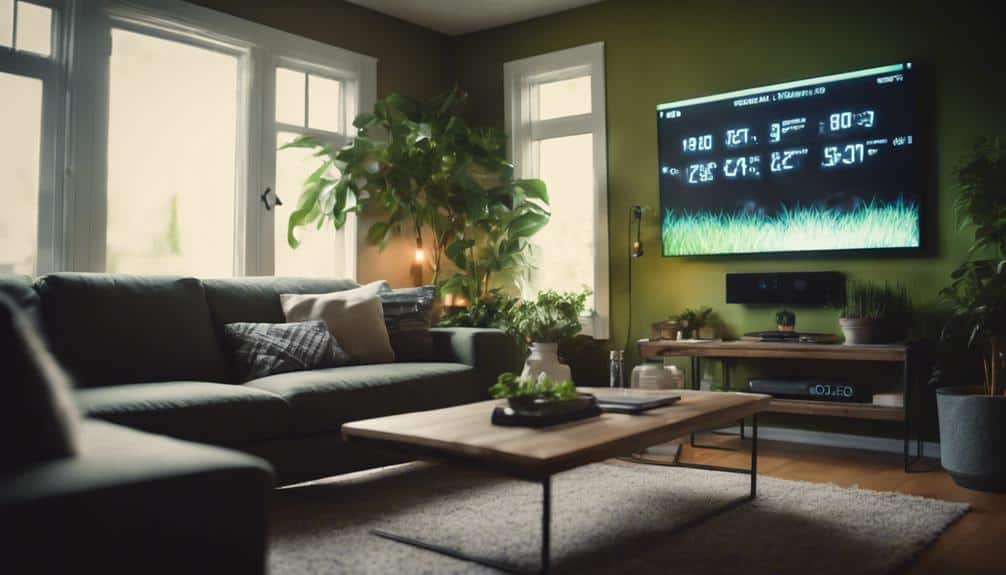
In today's world, you can save an average of $180 annually on energy costs by integrating smart thermostats into your home. These devices, when connected with smart home systems, not only enhance energy efficiency but also greatly reduce heating and cooling expenses. With a projected market size of $80 billion by 2023, it's clear that homeowners are recognizing the value.
In fact, nearly 70% of smart thermostat owners appreciate the ability for remote temperature control, seeing it as a key to opening up cost savings. By integrating these thermostats, you're looking at up to a 10% annual reduction in your energy bills. This step towards energy efficiency doesn't just save money; it's a leap forward in managing your home's climate smartly and sustainably.
Security and Safety Features
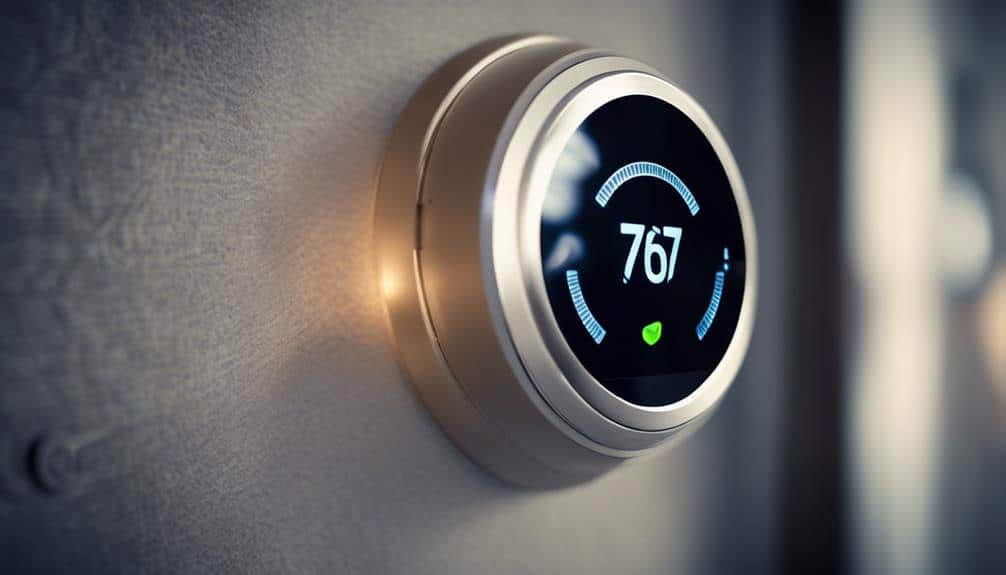
Smart thermostats go beyond temperature control, enhancing your home's security and safety with innovative features. By integrating these devices into your smart home system, you're not just managing energy use but also bolstering your home's defenses. Here's how:
- Live feeds and alerts: Pair with security cameras for real-time monitoring and notifications of unusual activity.
- Motion sensors: Detect movement within your home, adding an extra layer of safety.
- Programmed lighting: Simulate occupancy to deter potential intruders, making it seem like someone is always home.
- Smart lighting integration: Receive alerts and control lighting based on occupancy or set schedules, ensuring lights are on when needed for security.
These security features and safety integration options offer peace of mind, combining comfort with smart home security.
Getting Started With Integration
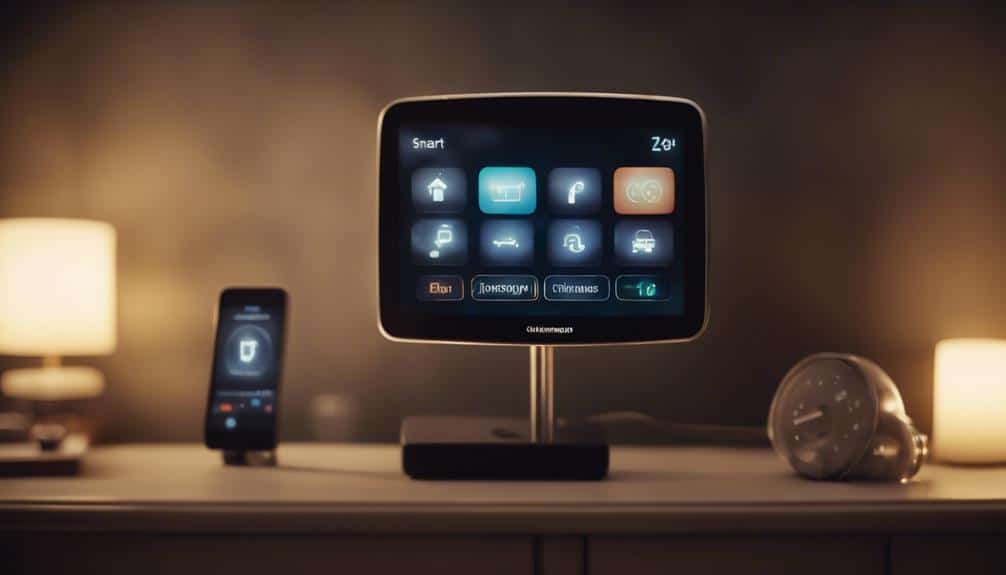
To kick off your smart thermostat integration, you'll first need to make sure your devices are compatible.
We'll guide you through the setup process, step by step, making it straightforward.
If you hit any snags, we've got troubleshooting tips to get you back on track quickly.
Choosing Compatible Devices
You'll need to guarantee your new smart thermostat works seamlessly with your current home setup by checking its compatibility with platforms like Google Home or Amazon Alexa. When choosing, consider these important factors:
- Wireless Connectivity: Make sure it supports Wi-Fi or Bluetooth for easy syncing with other devices.
- Automation Capabilities: Look for programmable schedules to tailor heating and cooling to your needs.
- Energy Monitoring: Choose a thermostat that provides energy usage reports to optimize consumption.
- Integration Options: Opt for models that work with third-party devices, expanding your smart home ecosystem.
Setup Process Overview
After selecting a smart thermostat that meets your needs, the next step is setting it up for integration with your home's HVAC system. The setup process involves a few straightforward steps. To start, make sure your smart thermostat is a compatible device with your smart home system. Then, follow the installation and setup instructions meticulously to connect it to your HVAC system.
| Step | Action |
|---|---|
| 1 | Download the app from the app store. |
| 2 | Create an account for personalized settings. |
| 3 | Connect the thermostat to your HVAC system. |
| 4 | Link other smart devices for enhanced automation capabilities. |
Using the app, you'll gain remote control over your thermostat, allowing you to fine-tune your home's temperature and automation capabilities, creating a cohesively smart environment.
Troubleshooting Common Issues
Despite setting up your smart thermostat correctly, you might encounter some common issues that can hinder integration with your home's systems. Here's how you can troubleshoot:
- Check smart thermostat compatibility with your existing smart home system to guarantee seamless integration.
- Verify Wi-Fi connectivity and signal strength to maintain reliable communication, important for adjusting temperature and avoiding connectivity issues.
- Update the firmware of your smart thermostat regularly to access the latest features and bug fixes, potentially resolving unexpected problems.
- Guarantee a proper power supply to your thermostat to prevent malfunctions or connectivity issues.
Troubleshooting involves restarting devices, including your thermostat and router, to refresh connectivity. These steps are pivotal for effective smart home integration, keeping your space comfortable and your system running smoothly.
Unifying Smart Home Devices: The Role of Thermostat Integration
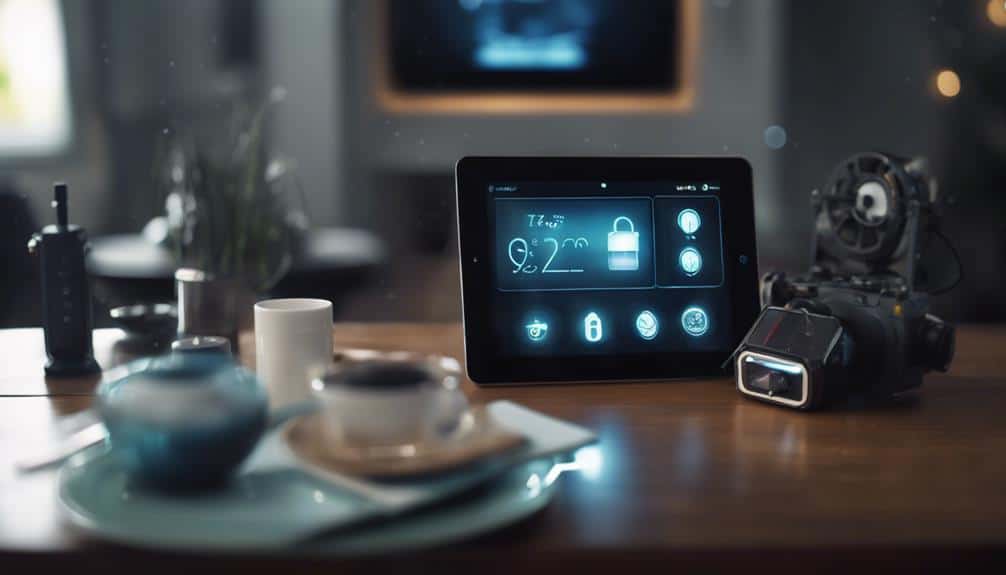
Bringing together your smart home devices starts with integrating a smart thermostat, serving as the core for effortless temperature control and energy efficiency. By syncing your smart thermostat with other devices, you elevate comfort and optimize HVAC systems. Imagine adjusting temperatures with voice control or enjoying personalized climate control that learns your preferences. Integration means zoned heating adapts to your needs, and remote access keeps you in command, all within a unified smart home ecosystem.
| Feature | Benefit |
|---|---|
| Voice Control | Hands-free HVAC adjustments |
| Personalized Climate Control | Learns and adapts to your preferences |
| Zoned Heating | Customized comfort and energy savings |
| Remote Access | Control from anywhere |
Integration isn't just about convenience; it's about creating a smarter, more efficient home.
Frequently Asked Questions
Is There a Downside to Smart Thermostats?
Yes, smart thermostats have downsides including privacy concerns, high initial cost, a learning curve, compatibility issues, battery dependency, required internet, frequent firmware updates, technical glitches, risk of overreliance, and a debate over actual energy savings.
Can You Have Two Smart Thermostats in One House?
Yes, you can have two smart thermostats in your house for dual-zone control, offering personalized temperature settings, energy efficiency, and scheduling flexibility. Despite the cost and installation process, the benefits in comfort and efficiency outweigh the drawbacks.
Do Smart Thermostats Work With Any HVAC System?
Smart thermostats generally work with any HVAC system, but you'll need a compatibility check and possibly adjust wiring requirements. They optimize energy savings and offer zone control, but retrofitting challenges and firmware updates may arise.
How Do Smart Thermostats Connect?
Smart thermostats connect using Wi-Fi or Bluetooth. You'll need to check compatibility, install it, then use mobile apps for remote adjustments. Enjoy energy savings and voice control with geofencing technology for an intuitive user interface.
Conclusion
Integrating a smart thermostat into your smart home system isn't just about upping your tech game; it's about living smarter. By connecting with home automation platforms and utilizing sensors and AI, you'll boost your home's energy efficiency and save money.
Plus, you'll enjoy the comfort of zoned heating and cooling, along with enhanced security features. Getting started is straightforward, and the benefits of unifying your smart devices through thermostat integration are clear.
Embrace this step towards a more connected, efficient, and secure home.

